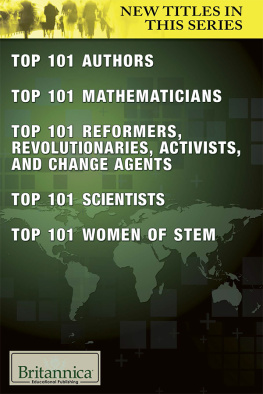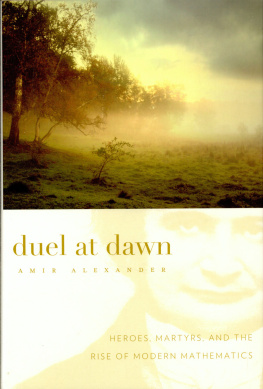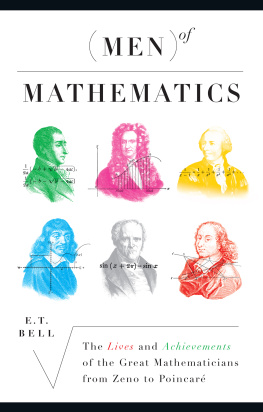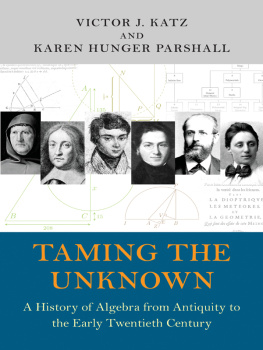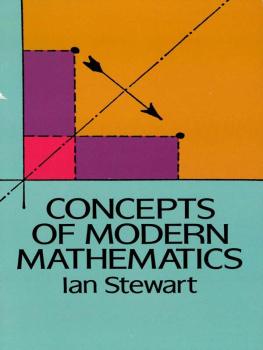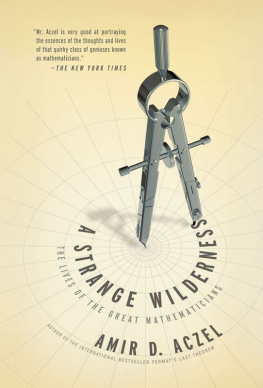
Published in 2017 by Britannica Educational Publishing (a trademark of Encyclopdia Britannica, Inc.) in association with The Rosen Publishing Group, Inc.
29 East 21st Street, New York, NY 10010
Copyright 2017 by Encyclopdia Britannica, Inc. Britannica, Encyclopdia Britannica, and the Thistle logo are registered trademarks of Encyclopdia Britannica, Inc. All rights reserved.
Rosen Publishing materials copyright 2017 The Rosen Publishing Group, Inc. All rights reserved
Distributed exclusively by Rosen Publishing.
To see additional Britannica Educational Publishing titles, go to rosenpublishing.com.
First Edition
Britannica Educational Publishing
J.E. Luebering: Director, Core Reference Group
Anthony L. Green: Editor, Comptons by Britannica
Rosen Publishing
Amelie von Zumbusch: Editor
Nelson S: Art Director
Michael Moy: Designer
Cindy Reiman: Photography Manager
Bruce Donnola: Photo Researcher
Cataloging-in-Publication Data
Names: Coakley, Louis C., editor.
Title: Top 101 mathematicians / edited by Louis C. Coakley.
Other titles: Top one hundred and one mathematicians
Description: First edition. | New York : Britannica Educational Publishing in association with Rosen Educational Services, 2017. | 2017 | Series: People you should know | Audience: Grades 7 to 12. | Includes bibliographical references and index.
Identifiers: LCCN 2016000256 | ISBN 9781680484960 (ebook)
Subjects: LCSH: MathematiciansBiographyJuvenile literature.
Classification: LCC QA28 .T67 2017 | DDC 510.922dc23
LC record available at http://lccn.loc.gov/2016000256
Cover (top, center left) Courtesy of the National Portrait Gallery, London; cover and interior pages border iStockphoto.com/urbancow
CONTENTS
M athematics is often defined as the study of quantity, magnitude, and relations of numbers or symbols. It embraces the subjects of arithmetic, geometry, algebra, calculus, probability, statistics, and many other special areas of research.
There are two major divisions of mathematics: pure and applied. Pure mathematics investigates the subject solely for its theoretical interest. Applied mathematics develops tools and techniques for solving specific problems of business and engineering or for highly theoretical applications in the sciences.
Mathematics first arose from the practical need to measure time and to count. Thus, the history of mathematics begins with the origins of numbers and recognition of the dimensions and properties of space and time. The earliest evidence of primitive forms of counting occurs in notched bones and scored pieces of wood and stone. Early uses of geometry are revealed in patterns found on ancient cave walls and pottery.
As civilizations arose in Asia and the Near East, the field of mathematics evolved. In Egypt and Mesopotamia, sophisticated number systems and basic knowledge of arithmetic, geometry, and algebra began to develop. The Greeks were the first to develop a truly mathematical spirit. They were interested not only in the applications of mathematics but in its philosophical significance. It was the Greeks who developed the idea of using mathematical formulas to prove the validity of a proposition.
The greatest contributions during the Middle Ages came from India and the Middle East. Indian mathematicians were especially skilled in arithmetic, methods of calculation, algebra, and trigonometry. One of the greatest scientific minds of Islam was al-Khwarizmi, who introduced the name ( al-jabr ) that became known as algebra. Consequently, the numbers familiar to most people are still referred to as Arabic numerals.
Mathematics received considerable stimulus in the 17th century from astronomical problems. In connection with such questions, the French mathematician Pierre de Fermat investigated properties of maxima and minima. He also discovered a method of determining tangents to curves, a problem closely related to the almost simultaneous development of the differential and integral calculus by Isaac Newton and Gottfried Wilhelm Leibniz later in the century. Of equal importance to the invention of the calculus was the independent discovery of analytic geometry by Fermat and Ren Descartes. The greatest achievement of the century was the discovery of methods that applied mathematics to the study of motion.

The ancient Greek mathematician Euclid, seen in this Renaissance engraving, was the primary source of geometric reasoning, theorems, and methods through the 19th century.
The greatest development of mathematics in the 18th century took place on the Continent, where monarchs such as Louis XIV, Frederick the Great, and the Empress Catherine the Great of Russia provided generous support for science, including mathematics.
The 19th century witnessed tremendous change in mathematics with increased specialization and new theories of algebra and number theory. The entire scope of mathematics was enriched by the discovery of controversial areas of study such as non-Euclidean geometries and transfinite set theory. Non-Euclidean geometries, in showing that consistent geometries could be developed for which Euclids parallel postulate did not hold, raised significant questions pertaining to the foundation of mathematics.
Modern mathematics is highly specialized and abstract. The advance of set theory and discoveries involving infinite sets, transfinite numbers, and purely logical paradoxes caused much concern as to the foundations of mathematics. In addition to purely theoretical developments, devices such as high-speed computers influenced both the content and the teaching of mathematics. Among the areas of mathematical research that were developed since the 20th century are abstract algebra, non-Euclidean geometry, abstract analysis, mathematical logic, and the foundations of mathematics.
Our understanding of mathematics is thanks to the brilliant work of many different mathematicians. This volume highlights 101 of the influential figures in the field.
(b. 1802d. 1829)
T he Norwegian mathematician Niels Henrik Abel made a remarkable series of contributions that were not fully recognized during his lifetime. He is known for his work with integral equationsmathematical expressions that are used to compute the area beneath a curve. Integral equations have broad practical application in surveying and engineering. Abel also investigated the field of elliptic functions. (An ellipse is an oval with special properties.)
Niels Henrik Abel was born on August 5, 1802, on the island of Finny, near Stavanger, Norway, the son of a Lutheran minister and politician. Abel was an unremarkable student until his 15th year, when his school hired Bernt Holmboe to teach mathematics. Holmboe recognized Abels talent and encouraged him. The pupil soon surpassed his teacher.
Abels father died in 1820, leaving the family almost without funds. When he entered the University of Oslo the next year, Abel was supported by several admiring professors who contributed to his upkeep from their salaries and invited him to their homes for meals. For four years he remained at the university, studying independently much of the time and writing papers on mathematics.
In Berlin in 1825, Abel met August Leopold Crelle, a German engineer with an intense interest in mathematics, who was then starting a mathematical journal. Crelle published many papers by Abel.

